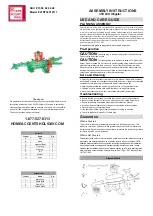
Instruction Manual
a)
The remote device powers the loop, where, depending on the ground
referencing requirements of that device, the connection can be as shown in
the diagrams below:
V+
Remote Voltage
ve
Remote Current
Input
V-
CVO4
+
–
I
d
or
V+
CVO4
Remote Current
Input
V-
+
I
d
b)
The SDM-CVO4 provides the voltage source to drive the loop. In this case
the only real option is:
Remote Current
Input
CVO4
+
–
V
o
I
d
In both cases you need to consider whether the voltage supply is high enough to
allow the maximum current to flow (20 mA) through all of the series resistances
in the current loop. When considering this factor you need to allow for a
minimum 2.5 V drop between the I
d
and
terminal of the
SDM-CVO4. You need to add this value to the estimated drop of 20 mA flowing
through the total resistance of the cable in the ‘loop’ plus any voltage drop in the
remote device (normally the voltage drop across a fixed sense resistor).
As a simple example, consider the situation where the SDM-CVO4 is powering
the loop (as in (b) above), then the supply voltage output from V
o
is 13.5 (absolute
minimum). If the remote device has a 250 ohms sense resistor this will drop 5V at
20mA (using Ohm’s law), which in addition to the
SDM-CVO4's 2.5 V drop in the loop means the maximum allowable voltage drop
in the cable of the loop should be 13.5 - 5.0 - 2.5 = 6.0 V. At 20 mA current flow,
the loop could therefore have a maximum resistance of 300 ohms. Standard 24
AWG (7/0.2 mm) cable has a typical resistance of 85 ohms per 1000 m. Allowing
double this resistance to form a loop (there and back), will mean the total cable
length could be as long as 1700 m before the supply voltage started to limit the
current flowing.
7














































